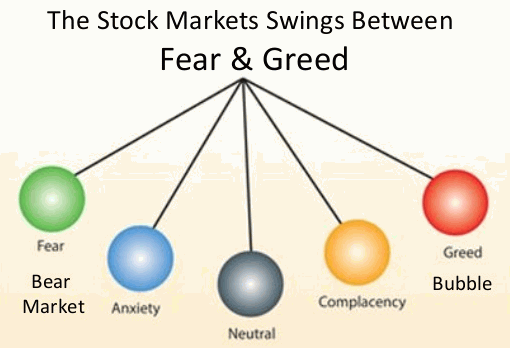Psychology/emotions affect corporate profits and investment cycles as well. We have seen the pendulum swings in both the extreme and investment world also moves in the same way.
Between euphoria and depression, between celebrating positive developments and obsessing over negatives, and thus between being overpriced and underpriced.
And few other observations of the pendulum – between greed and fear, between optimism and pessimism, between risk tolerance and risk aversion, between credence and scepticism, between faith in value in the future and insistence of concrete value in the present, and between the urgency to buy and panic to sell.

Above is average return but what about good and bad cycle?

When people feel good about the investment, Optimistic about it then they are in the greed and buy more which resulted in the increase of assets prices. On the other hand, when they do not feel good about the investment, pessimistic about it then sell their assets which reduces the prices of assets. Sometimes market plays between a range where greed and fear both having a stronghold.
When investors do not feel fear then prices of assets keep on raising up. Similarly happens during the tech boom 1999-2000, subprime in 2003-2007 and current scenario.
Somehow the greed evaporated and fear took over. “Buy before you miss out” was replaced by “Sell before it goes to zero.” When greed is high then people find for next Infosys, top-performing private sector banks but when fear is higher than seeing each as a next Yes bank, DHFL.
Other factors such as euphoria and depression are an extension of greed and fear. Continuing greed translated into the euphoria and fear into the depression.
When prices of assets raise then people believe in any stories prevailing in the market but reversely when prices falling then cheap assets does not get the attention of investors.

Superior investors are wise enough and they buy assets when it available at the discount from intrinsic value and there will be a potential to increase in intrinsic value.
For making such investment decisions, they need to keep a balance between greed and fear. Very few investors remain cool and unemotional to stay at the midpoint of fear & greed. Else, the majority of people remains greedy when everyone is optimistic and fearful when everyone is pessimistic. The pendulum moves from one extreme to the other and remains quiet for midpoint. For becoming a superior investor, we need to be unemotional to such swings. Emotional people will require a great deal of self-awareness and self-restraint for becoming a successful investor.
People generally remains biased with their emotions to reach any conclusion.
INTEREST RATE CUTS: DOES IT PROVIDE LONG-TERM BENEFITS?
Many times, it has been noticed that news over both extreme – positive and negative but market keep on rising.
So that, Interpretation of the data has importance. During the depression time, positive news getting ignored and negative news only getting rewarded. Reversely, during the euphoric situation, negative news getting ignored and positive news only getting rewarded. Saving ourselves from such traps results in the superior investment returns and long-term survival of our wealth.
Disclosure – Companies mentioned in the article are just for an example & educational purpose. It is not a buy/sell/ hold recommendation.
Read for more detail: Mastering The Market Cycle: Getting the odds on your side by Mr.Howard Marks

















